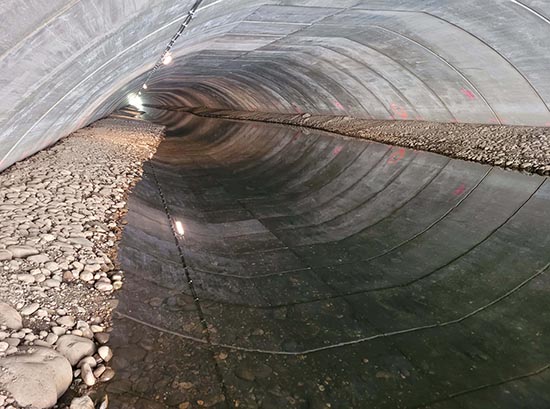|
Subscribe / Renew |
|
|
Contact Us |
|
| ► Subscribe to our Free Weekly Newsletter | |
| home | Welcome, sign in or click here to subscribe. | login |
Construction
| |
 |
February 6, 2023
Best In State: Gold Award
Exceeding Client/Owner Expectations

KPFF Consulting Engineers
Project: JBLM emergency culvert repair
Client: Seattle District, U.S. Army Corps of Engineers
The sudden collapse of two rusted, 70-year-old, 12-foot-diameter culverts crossing under JBLM’s airfield forced an emergency closure of half of the runway. The team of KPFF and Brice Civil Constructors creatively worked to find solutions and reopened the runway in less than seven months, finishing 25 days ahead of schedule. The new design also improved the critical fish ecosystem by providing a more natural environment with a meandering gravelly streambed.
Utilizing an accelerated design-build approach, the team worked quickly to develop innovative solutions to solve this complex, imperative issue as sinkholes suddenly appeared around the airfield. The danger posed to the 62nd Airlift Wing and its C-17 aircraft meant half the runway and taxiway remained off limits, significantly impacting the ability of the Air Force to provide global airlift support. It was integral to the project that there was a seamless flow of moving pieces, impacting active military operations as little as possible.
The project was fast-paced and high-risk, and separated into two phases. The first phase included restoring the use of the runway and required restoration of all areas disrupted by construction within 225 feet of the runway center. The second phase focused on completing all remaining work and included the construction of the taxiway and apron without impacting aircraft operations.
The team’s challenges included: diverting Clover Creek during construction; lowering the groundwater table and treating 850 million gallons of contaminated groundwater; demolishing the existing culverts; excavating over 300,000 cubic yards of soil; and constructing and backfilling a 1,800-foot-long, 50-foot-wide arched precast fish passage with a natural streambed. Phase 2 included 240,000 cubic yards of backfill and repaving 60 acres of the runway, taxiway, and apron during freezing temperatures.
The innovative cost and time-saving design used to construct the fish passage included a modular precast Bebo bridge system from Contech Engineered Solutions. This structure consisted of 600 arched segments, 50 feet wide by 1,800 feet long, and buried 30 feet deep. It is the longest viable fish passage facility in North America. Subsequent observations have proved that salmon are migrating through this subterranean creek designed to mimic a natural stream, aided by LED lights and a manmade streambed.
Construction of the new fish passage required dewatering and treating over 850 million gallons of contaminated groundwater before discharging into the environmentally sensitive Clover Creek. Brice Civil Constructors designed a system that treated an unprecedented 10,000 gallons per minute, 24/7, without a single discharge event exceeding the treatment threshold of 70 parts per trillion. The treatment effort was the largest known volume of water ever treated at this level of flow rates on a single project.
The design priorities emphasized sustainable features through consistent cooperation with the U.S. Army Corps of Engineers — which will positively impact the quality of life for generations of U.S. service members and the communities around JBLM, leaving a lasting legacy.
Other Stories:
- National Finalist: Platinum Award
Transportation - Best In State: Gold Award
Future Value To The Engineering Profession - Best In State: Gold Award
Social, Economic And Sustainable Design - Best In State: Gold Award
Complexity - Best In State: Gold Award
Unique Or Innovative Application Of New Or Existing Techniques - National Finalist: Gold Award
Surveying/Mapping Technology - National Finalist: Gold Award
Special Projects - National Finalist: Gold Award
Structural Systems - National Finalist: Gold Award
Structural Systems - Diversity And Inclusion Award: Mid-Sized Firm
- Diversity And Inclusion Award: Large Firm
- Engineer of the Year
- National Finalist: Gold Award
Transportation


